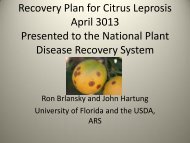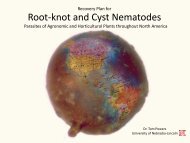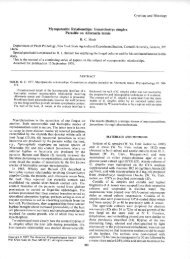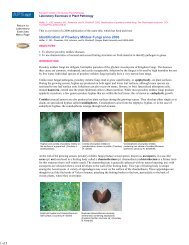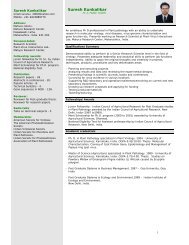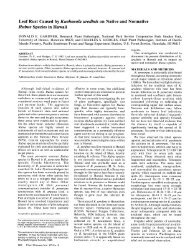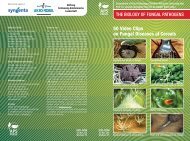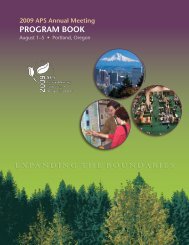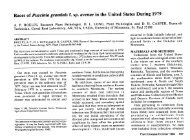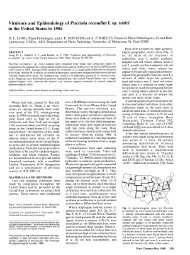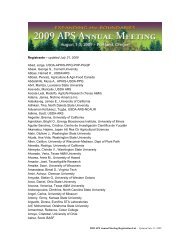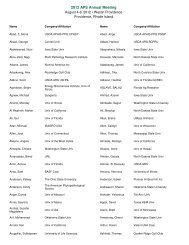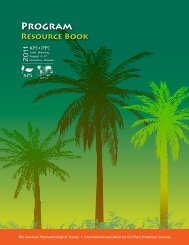view article - American Phytopathological Society
view article - American Phytopathological Society
view article - American Phytopathological Society
You also want an ePaper? Increase the reach of your titles
YUMPU automatically turns print PDFs into web optimized ePapers that Google loves.
276 BORNE AND FOLIAR PATHOGENS IN PEANUT. H. S. McLean and<br />
P. Schmid. Sandoz Crop Protection, 1300 East Touhy Avenue,<br />
LY211795 - A Novel Foliar Applied Fungicide for Control of Des Plaines, IL 60018.<br />
Powdery Mildew in Cereals and Grapes. W. R. Arnold, M. J.<br />
Coghlan, H. R. Hall, E. V. Krumkalns, Lilly Research Cyproconazole, a-(4-chlorophyenyl)-(I cyclopropylethyl 1)-i 1,<br />
Laboratories, A Division of Eli Lilly and Company, P. 0. Box 2,4-triazole-lethanol, is a new broad spectrum fungicide with<br />
708, Greenfield, IN. C. Longhurst, Lilly Research Centre Ltd., excellent systemic activity. Cyproconazole systemic activity<br />
Erl Wood Manor, Windlesham, Surrey GU20 6PH, UK. is characterized by rapid plant tissue penetration and acropetal<br />
translocation. In field trials conducted 1984-1988, cypro-<br />
Lilly 211795 is highly effective as a foliar fungicide on wheat conazole has consistently provided control of important foliar<br />
and barley powdery mildew (Erysiphe graminis; f. spp. tritici and soil borne diseases in peanut when applied at relatively<br />
and hordei, respectively) and grape powdery mildew (Uncinula low rates (0.061-0.098 kg ai/ha) on a 14-21 day spray schedule.<br />
necator). The compound penetrates into the plant tissue very Early and Late leafspot (Cercospora arachidicola and Cercosporirapidly<br />
and is translocated acropetally. Compound 211795 shows dium personatum) are easily controlled with cyproconazole.<br />
excellent protectant activity against mildew resistant to DMI Southern Blight (Sclerotium rolfsii) and Rhizoctonia limb rot<br />
chemistry. When used in mixtures with other fungicides, a wide (Rhizoctonia solani) are also controlled by foliar applications<br />
range of diseases can be controlled, of cyproconazole within the same rate range as listed for leafspot.<br />
Peanuts have excellent tolerance to Cyproconazole and<br />
display virtually no plant growth regulation effects.<br />
277<br />
THE EFFECTS OF PENCONAZOLE AND PROPICONAZOLE ON THE 281<br />
ULTRASTRUCTURE OF PYTHIUM ULTIMUM AND<br />
PHYMATOTRICHUM OMNIVORUM. J. R. Anciso and S. D. Lyda. Production of hydroxyl radical in photodynamDic biocidal reaction<br />
Department of Plant Pathology and Microbiology, Texas Agricultural of methionine riboflavin mixture. 0. 0. Tzeng, and N. H. Lee.<br />
Experiment Station, College Station, TX 77843. Department of Plant Pathology, National Chung Hsing University,<br />
The accepted mode of action of penconazole (Topasr) and propiconazole<br />
(Tiltr) is the inhibition of ergosterol biosynthesis. A time course study Production of hydroxyl radical (-OH) was detected from the<br />
on effects of the two chemicals on Pythium ultimum and methionine riboflavin mixture (MR) under continuous illumination<br />
Phymatotrichum omnivorum was investigated. The ED 5 0 for P. ultimum by the method developed by Baker and Gebicki. The rate of "OH<br />
is 25 ppm with penconazole and 98 ppm with propiconazole, while the production from MR was much greater at pHs 4.0-5.0 than at pHI<br />
ED 5 0 for P. omnivorum is 9 ppm with penconazole and .01 ppm with 6,0-8.0, which indicated the possible involvement of iron conpropiconazole.<br />
The ED 5 0 (minimum inhibitory concentration) was tamiinant in the reaction. The addition of exogenous iron was<br />
chosen as the concentration to observe ultrastructural changes. The<br />
primary observation was the loss of normal-appearing endoplasmic stirulatory to the -OH formation of nR. However, the presence<br />
reticulum and the abundant appearance of circular endoplasmic of iron chelators like desferal, or phenanthroline, and free<br />
reticulum-like material in the treated for both species. P. ultimum radical scavengers like thiourea, all greatly reduced the radiwhich<br />
does not synthesize or require sterols has shown "moderate cal forming activity. At pH 4.0, it was also noted that addisensitivity"<br />
to penconazole in greenhouse and in vitro tests. These tion of ascorbic acid or H 2 0 2 at certain concentrations greatly<br />
similar ultrastructural changes found in the nonsterol-synthesizing P. enhanced the generation of the test radical. The rapid increaultimum<br />
and the sterol-synthesizing P. omnivorum suggest that another ment of -OH formation via the iron catalyzed Haber-Weiss reacmode<br />
of action exists for both of these triazoles. tion was apparently a major factor which contributed to the<br />
278<br />
RESPONSE OF CYST-NEMATODE RESISTANT AND SUSCEPTIBLE<br />
SOYBEAN CULTIVARS TO IN-FURROW APPLICATIONS OF 282<br />
photodynamic biocidal activity of MR.<br />
ALDICARB. P. M. Phipps, Tidewater Agr. Exp. Sta., VPI&SU, Suffolk, VA<br />
23437-0099. THE EXPRESSION OF RESISTANCE OF USTILAGO AVENAE TO<br />
TRIADIMENOL IS AN INDUCED RESPONSE. Wolfram Kdller and<br />
Franzine 0. Smith, Department of Plant Pathology, N Y State<br />
Soybean cultivars were evaluated with and without applications of aldicarb Agricultural Experiment Station, Geneva, NY, 14456.<br />
(Temik 15G) in fields naturally infested with soybean cyst nematode (SCN) in<br />
1987 and 1988. Cultivars were main plots consisting of six 10.7-m rows spaced A strain of U. avenae sensitive to triadimenol (sen) and a<br />
0.9-m apart. Treatments were applied to the seed furrow of two-row subplots menol resistant (2mg/L) laboratory after 15 mutant h of growth (rl) were in treated liquid culture. with triadi-<br />
at planting. The experimental design employed 9Initially, four randomized complete Inil rerodcto reproduction of<br />
of both<br />
in was<br />
strains<br />
altcme t<br />
was almost completel<br />
blocks. The effect of cultivars on nematode populations and yield was blocked; however, the inhibitory phase was transient for rl,<br />
significant (P=0.05), however, aldicarb only had a significant effect on yield. and full growth resumed after 10 h. This pattern of initial<br />
The overall yield of SCN-resistant cultivars (Centennial, Forrest, Pioneer Brand growth inhibition and subsequent recovery was correlated with<br />
P9581) averaged 2576 kg/ha (38.3 bu/A) compared to 1917 kg/ha (28.5 bu/A) a decline of sterol precursors, as analyzed by GC-MS. Al-<br />
for susccptible cultivars (Essex, York). Aldicarb at 0.56 and 1.12 kg/ha though precursors (pre-dominantly 24-methylenedihydrolanosterol)<br />
accumulated during the phase of growth inhibition,<br />
improved yield of susceptible cultivars 276 and 390 kg/ha (4.1 and 5.8 uA) and also were still prominent at the onset of renewed growth,<br />
and yield of resistant cultivars 363 and 356 kg/ha (5.4 and 5.3 bu/A), they were absent after 24 h of treatment with triadimenol.<br />
respectively. Pulse-labeling of sterols at various time intervals after<br />
treatment with the inhibitor revealed that the continuous<br />
disappearance of precursor sterols is not explained by a<br />
dilution of the inhibitor from the target site.<br />
279<br />
EFFECTS OF FUNGICIDE RH3486 ON SCLEROTINIA BLIGHT OF<br />
PEANUT IN HIELD AND MICROPLOT TESTS. F. D. Smith, P.M. Phipps 283<br />
and R. J. Stipes, Tidewater Agr. Exp. Sta., VPI & SU, Suffolk, VA 23437. NTRDSESBEGAUE EHOOY .. Lro<br />
~and The fungicide, RH3486, and several other<br />
J.M.<br />
fungicides<br />
Denis.<br />
were<br />
UCB<br />
evaluated<br />
Chemicals<br />
for control<br />
Corp., 5365-A<br />
Hood<br />
Robin<br />
Rd., Norfolk, VA 23513 and UCB Chemical Sector,<br />
of Sclerotinia blight of peanut, caused by Sclerotinia minor. Two applications Ave. Louise 326, B-1050 Brussels, Belgium.<br />
of RH3486 at 0.56 or 1.12 kg a.i./ha significantly (P=0.05) suppressed disease<br />
69 and 81% and increased yields 2191 and 2243 kg/ha, respectively. Similar UCB is one of the world's leading producers of<br />
applications of iprodione (1.12 kg/ha), vinclozolin (0.84 kg/ha), dicloran (3.36 methylamines and their derivatives such as Thiram<br />
kg/ha) or PCNB at (5.60 kg/ha) suppressed disease only 42, 47, 21 and 18%, and Ziram fungicides. In efforts to improve worker<br />
respectively. Microplots, 76-cm-dia., were infested with S. minor sclerotia from safety,<br />
strinS-<br />
UCB<br />
-8-T<br />
evaluated<br />
(wldtye)or (icaboimderesstnt<br />
other methods for<br />
ad<br />
formulating<br />
panedto Thiram and Ziram and concluded that the water-<br />
strinS-2(wld-yp)<br />
r B83T2 diaroxiid-reisan) ad lanedto dispersible granule (WG) formulation was the most<br />
Florigiant peanut. Plots treated three times with RH3486 at 1.12 kg/ha<br />
averaged 0 and 1.0 lesions/plot with strain S-2 and B-83-T2, respectively,<br />
Untreated plots likewise averaged 27.0 and 31.5 lesions/plot. Three applications<br />
of iprodione at 1.12 kg/ha did not significantly suppress disease caused by either<br />
strain. Two years of similar field data have shown RH3486 to be an extremely<br />
active fungicide against wild-type and dicarboximide-resistant strains of S. minor,<br />
apr rit. TeW tchogydvledbUC hs<br />
been registered under the trade name "GRANUFLO."<br />
The high quality granules readily disperse in water<br />
and offer many advantages over traditional formula-<br />
tions including being virtually dust-free, easy to<br />
package, easy to handle, insensitive to temperature<br />
280<br />
CYPROCONAZOLE: A NEW SYSTEMIC FUNGICIDE FOR CONTROL OF SOIL<br />
variations and having improved product efficacy.<br />
The Granuflo technology allows opportunities for<br />
formulating associations of fungicides which are<br />
useful in developing anti-resistance strategies.<br />
1170 PHYTOPATHOLOGY



